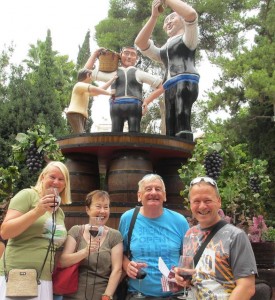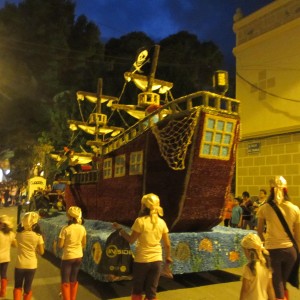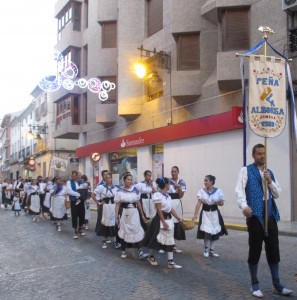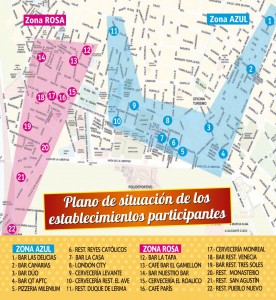There’s always something happening in Jumilla, but during the month of August it seems to be one long party, with music, folk dancing, Moors and Christians, various sporting competitions and – not surprisingly – lots of wine!
The celebrations have already begun, with the Noche de las Antorchas and the Offering of Flowers to La Virgen de la Asunción (the Patron saint of Jumilla) both taking place last weekend. Don’t worry though as there are plenty more events for you to enjoy in Jumilla between 10 and 19 August.

There is so much happening that I’m just going to highlight the key events, which also happen to be my favourites, and I will write two separate posts.
Friday 10 August 20.30
The inauguration ceremony of the Feria & Fiestas 2018 will start at the Town Hall. Then there will be a procession to the Folklore Monument, to the Jardín Rey Don Pedro for the inauguration of the Fuente del Vino (the photo below shows the fountain from a previous year) finishing at the Moors and Christians campsite on the Paseo Poeta Lorenzo Guardiola.

22.30 Jardín de La Glorieta
There will be free entry to the IX Festival Juvenil de Bandas de Música, with our two excellent local bands taking part.
Saturday 11 August 12.00
The miniferia del vino will already be in most people’s diaries, including mine! It takes place in the Jardín del Rey Don Pedro. It is an opportunity to taste some of Jumilla’s best wines, as the main bodegas will have stands in the garden. I will update this page when I have more details, however usually you pay 5€ for a wine glass that you can take home and then you can wander around the stands sampling the wines. It is advisable to either book a hotel in town that evening or arrange for your personal chauffeur or a taxi to take you home, unless you live in town like me and can just stagger home afterwards!
19.00 – 01.00 (Saturday and Sunday)
I always enjoy the Artisans Market on the Paseo Poeta Lorenzo Guardiola, as it is a chance to buy something original and also to support local artisans.
22.00
The inaugural session of the 35 National Folklore Festival will take place in the Jardín de la Glorieta and will be free.
Sunday 12 August 21.30
The main parade of the Moors and Christians will start at the Arco de San Roque, going along Cánovas del Castillo to la Plaza del Rollo (beside the tourist office). This colourful spectacle is one of my favourite events.
23.30
Folk evening in the Jardín de la Glorieta, with the group Luar na Lubre. This is another free concert and one that I definitely won’t miss, having discovered that this Galician group not only has someone playing the bagpipes but also has a soloist with a beautiful voice.
Monday 13 August 20.00
The Cabalgata Infantil de la Vendimia is always fun to watch, as the children enjoy themselves so much, the floats are impressive (as shown below) and the costumes are colourful and imaginative. It starts near my house and continues along Canovas del Castillo, turning down Avenida de la Asunción and then onto Avenida Levante, finishing at the indoor market.
22.00
The closing act of the Folklore Festival will be another free session, taking place in the Jardín de la Glorieta.
Tuesday 14 August 20.00
The Procession of the Peñas (local associations) taking part in the Ofrenda de Uvas (Offering of the Grapes) starts on the Paseo Poeta Lorenzo Guardiola and winds around the town, finishing in the Jardín de la Glorieta. Participants are dressed in traditional costumes, carrying their baskets of grapes, and accompanied by music. The evening ends with the treading of the grapes and offering the first must (freshly crushed grape juice) to the “Niño de las Uvas”. If you haven’t seen it before it’s a definite “must”!
Click on the following link to see the street map of Jumilla if you are unfamiliar with the town and would like to join in our fiestas.



















 The Castillo overlooking Jumilla.
The Castillo overlooking Jumilla.





